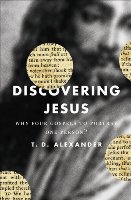Today we continue our very informative interview with T. Desmond Alexander, as he talks to us about Jesus as he is presented in the four Gospels and his book, Discovering Jesus? Why Four Gospels to Portray One Person. If you missed Part 1 of this interview, you can catch up here.
Books At a Glance (Fred Zaspel):
In the early centuries of the church, Matthew’s Gospel was believed to have been written first. Most scholars today believe that Mark’s Gospel was first. Does this question make an interpretive difference at any point?
Alexander:
The order in which the Gospels were written is relatively unimportant if you believe that all four accounts provide an authoritative picture of Jesus. Unfortunately, there are New Testament scholars who reject this assumption, believing that the present Gospels cannot be fully trusted, but contain material that was created by the early church to enhance falsely the historical Jesus. The reductionist approach of these scholars means that they largely ignore the four distinctive portraits of Jesus found in the canonical gospels. For these they substitute a reconstructed picture, which they claim is more accurate. For my part, I’m inclined to trust more the gospel writers, who were much closer to both Jesus and those who knew him, than the modern scholars, who are far removed from the time of Jesus.
Books At a Glance:
Over the years there has been much conjecture about the “messianic secret” in Mark’s Gospel, that Jesus often commands his disciples to keep his messianic identity to themselves. Explain for us why Jesus avoids describing himself openly as the Son of God?
 Alexander:
Alexander:
The so-called ‘messianic secret’ reflects something that was a troubling issue for the historical Jesus. As reflected in all the Gospels, Jesus’ contemporaries had mistaken beliefs regarding the promised Messiah. We see this reflected in Peter’s refusal to accept that Jesus would suffer and die. For Peter, the Messiah would be a victorious king who would defeat the powers of evil. Jesus’ messiahship, however, would include death upon a cross. Jesus knew this from the outset and he did not wish his followers to be misled by his displays of supernatural power. His followers could only truly understand Jesus after his death and resurrection. Any attempt to understand who Jesus was, apart from the cross, would be deficient. For this reason Jesus is reluctant to emphasize his messianic nature prior to his death on the cross. He did not wish his first followers to jump to wrong conclusions.
Books At a Glance:
What does discipleship look like according to Mark’s Gospel?
Alexander:
In the first chapter of his Gospel, Mark highlights the theme of following Jesus. Do you recall how he invites the fishermen to follow him? For Mark, discipleship is about following Jesus. Yet, importantly, Mark develops this theme by emphasizing that those who follow Jesus must be prepared, as Jesus said, to sacrifice their lives for the sake of others. Jesus expressed this in terms of taking up the cross. This involves denying ourselves the right to be first and living a life of service to others. As Mark points out in chapters 8-10, the disciples of Jesus struggled to grasp this concept. I suspect that ‘modern’ followers of Jesus still struggle with this aspect of discipleship.
Books At a Glance:
Explain for us how the Gospel of John reflects the book of Exodus and how this serves to shape John’s message.
Alexander:
When John sets out in 20:30-31 his reason for writing the Gospel, he tells us that he recorded these things about Jesus so that ‘by believing you may have the life in his name’. The concept of life or eternal life appears frequently in John’s gospel. Some of the best-known verses in John’s Gospel highlight this:
*John 3:16 – For God so loved the world that he gave his one and only Son, that whoever believes in him shall not perish but have eternal life;
*John 10:10 – The thief comes only to steal and kill and destroy; I have come that they may have life, and have it to the full;
*John 11:25 – Jesus said to her, “I am the resurrection and the life. He who believes in me will live, even though he dies.”
To explain how Jesus gives life to others, John draws on the Old Testament account of the Israelites’ deliverance from slavery in Egypt. In particular, he observes how the sacrifice of the Passover lambs gave life to the firstborn male Israelites. Importantly, John presents Jesus as the ‘Lamb of God’ (John 1:29, 36) who is executed at the time of the annual Passover in Jerusalem, and whose bones, like those of the Passover sacrifice, are not broken (John 19:36). To underline this Passover theme, John uses the term ‘Passover’ more frequently than other Gospel writers, and actually describes three separate occasions when Jesus went to Jerusalem to commemorate the Passover. In addition, John draws out other connections with the Exodus story, some of which are not immediately apparent to most readers. John records various ‘signs’ that move from the turning of water into wine to the resurrection of a firstborn Israelite (Lazarus). Remarkably, in the OT Moses performs various ‘signs’ before Pharaoh that move from turning water into blood to the death of the Egyptian firstborn males. While today we generally speak of Moses’ ‘signs’ as ‘plagues’, this was not so in the OT period. Ancient Israelites did not speak about the ‘ten plagues’; rather they referred to them as ‘signs and wonders’ (e.g. Deut. 6:22; Neh. 9:10; Jer. 32:20-21; cf. John 4:48). As the ‘signs’ in Egypt prepared for the Passover, so greater ‘signs’ prepare for the sacrifice of Jesus as the Passover lamb.
These and other features in John’s Gospel (e.g. the ‘I am’ sayings) underline that Jesus’ death brings life, just as the OT Passover sacrifices gave life to the firstborn male Israelites. However, the life that Jesus gives is considerably better, for his sacrifice far exceeds that of lambs and goats.
Books At a Glance:
Can you give some advice to preachers who set out to preach through one of the Gospels? If I am preaching, say, through Matthew, what kind of attention should I be giving to Mark, Luke, and John? And what kind of influence should they have?
Alexander:
I think it is very important for a preacher to recognize the dominant theme in a Gospel. This will color how they interpret and preach through the Gospel. When you compare Matthew’s account with that of Mark, it is immediately apparent that Matthew adds unique material to the start of his account of Jesus’ life. In Mark, the baptism of Jesus comes early in chapter 1; in Matthew, it comes in chapter 3. Why does Matthew add particular material at the start of his Gospel? The answer becomes slightly more obvious when we observe that Matthew presents Jesus as the ‘son of David’ (Matthew 1:1), whereas Mark concentrates on Jesus as the ‘Son of God’ (Mark 1:1).
In Matthew chapters 1-2 attention is given to the royal nature of Jesus as heir to the Davidic throne. In chapter 1 Matthew describes how Jesus becomes the legitimate heir to the Davidic throne when he is ‘adopted’ by Joseph. Continuing this royal theme, Matthew then describes how the Magi come looking for the newly born king, and how their actions introduce King Herod into the account of Jesus’ life. Although these events are ignored by the other Gospel writers, Matthew includes them because they draw attention to the royal nature of Jesus. This emphasis upon Jesus as the ‘son of David’ has important implications because Jesus, as the Messiah or Christ, fulfils Old Testament expectations associated with the Davidic dynasty. Consequently, throughout Matthew’s Gospel the idea is emphasized that Jesus has come as a Davidic king to begin the process of establishing God’s kingdom on earth. Among the different ways in which Matthew emphasizes this idea, he draws attention to how Jesus taught with authority (Matthew 7:29). Jesus even has the authority to forgive sins, and while this point is noted by both Mark (2:10) and Luke (5:24), Matthew gives emphasis to it by using the term ‘authority’ twice (Matthew 9:6, 8). This latter example illustrates that often the emphasis on a theme in a Gospel may be quite subtle. It is easy to miss the distinctive theme, if you are not looking for it. I hope these comments illustrate something of what I think a preacher ought to be looking for when working through a Gospel.
Note: You can catch up on Part 1 of this interview here.

